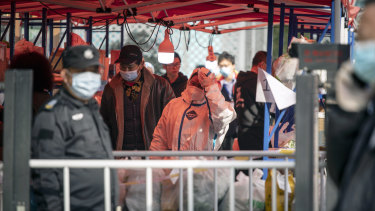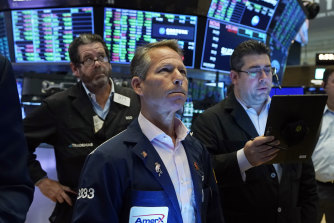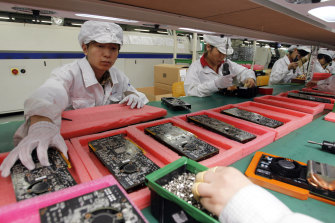China’s failing zero-COVID strategy risks collapsing the world economy

Just a few weeks ago central bankers were walking a tightrope; now they are tiptoeing along a rapidly fraying piece of string.
Even before Christmas there was a heated debate about whether raising rates and “normalising” monetary policy to curb inflation threatened to snuff out the nascent economic recovery as the world started emerging from its COVID nightmare.
Chinese authorities have started locking down multiple cities after COVID outbreaks, including Shanghai.Credit:Bloomberg
And then Vladimir Putin invaded Ukraine. This has resulted in a sharp spike in energy prices and left Europe “flirting on the edge of recession”, according to Peter Oppenheimer, chief global equity strategist at Goldman Sachs. His bank puts the risk of the US economy contracting in the next year at between 20 per cent and 35 per cent.
Oppenheimer points out that the longer the fighting goes on the more it stokes inflation and weakens growth, sharpening the horns of the dilemma upon which policy makers find themselves impaled.
Nothing illustrated this confluence of contradictory concerns better than the wild oscillations in the price of oil. Last week Brent crude shot up to $US139 a barrel. The International Energy Agency yesterday warned Russia’s attack on Ukraine could result in the biggest supply shock in a generation.
But, even as the grave prophecy was being reported, crude fell back down below $US100 as fears mounted that a global downturn could subdue demand. Oil is an extreme example but there has been pronounced volatility and dislocations in a variety of commodities and broader markets in recent days. Put simply, investors aren’t entirely sure what to worry about most.
Over the weekend they were confronted with a fresh concern as Chinese authorities started locking down multiple cities including Shanghai and Shenzhen, which borders Hong Kong. Shenzhen is a manufacturing and technology hub that is often described as China’s Silicon Valley. Apple supplier Foxconn and dozens of other factories have been forced to close down.
Chinese media is reporting that the surge in cases appears to have been triggered by people having travelled from Hong Kong, which is currently suffering the world’s worst spike in COVID deaths. An astonishing one in every 20 COVID cases there is resulting in the patient’s death, according to analysis by the Financial Times’s John Burn-Murdoch.
When omicron hit at the turn of the year, more than two-thirds of over-80s in Hong Kong were still unvaccinated. In mainland China, the picture isn’t much better. Estimates suggest that as much as 40 per cent of over-80s in the country haven’t had a jab – that’s 15 million people.
There are a variety of theories about why this is. The most plausible explanation is that vaccines, especially those based on mRNA, were perceived to have side effects and the risks weren’t worth running if the authorities were true to their word about keeping the virus at bay.
In a tragic inversion of what has happened in much of the rest of the world, this means the young and healthy are more likely to be vaccinated than the elderly. Authorities are trying to make up for lost time but they are now chasing a wave of infections rather than getting out in front of it.
Investors are facing challenges on many different fronts.Credit:AP
Most other countries, including New Zealand, which imposed severe travel restrictions for much of the pandemic, have now accepted that COVID is endemic and we must learn to live with it. In mainland China, the eradication of COVID is still government policy. Reversing course and launching a drive to get more of the population vaccinated would be tantamount to admitting a catastrophic error.
It seems that having unleashed this virus on the world, China’s dogged and increasingly doomed zero-COVID policy will ensure the damage wrought by the pandemic could drag on for months to come.
In an eerie echo of the early days of the pandemic, supply bottlenecks are already beginning to emerge with the number of container ships waiting off some of China’s biggest ports almost doubling compared to February, according to Bloomberg data. And that’s all before factoring in the possibility of sanctions being imposed on China if Beijing were to respond to Moscow’s requests for financial and military aid.
Will this further boost inflation or retard growth? We already know the answer from earlier in the pandemic: both. The string central bankers were balancing on has become a thread. So, how should they proceed?
Put simply, investors aren’t entirely sure what to worry about most.
Well, as the old jokes goes, I wouldn’t start from here. With inflation nudging 8 per cent, unemployment below 4 per cent, rates at zero and quantitative easing only just coming to an end, US monetary policy is, as Russell Silberston of fund manager Ninety One says, “in utterly the wrong place”. The Bank of England has moved a little more in the right direction but not much.
The US labour market has been tight for a while but it’s getting much tighter in the UK too. Unemployment is close to the pre-pandemic rate of 3.8 per cent and job vacancies have hit a new record high. This will likely fuel Bank fears that inflation is feeding into higher pay and things could soon start spiralling out of control.
On the flipside, if annual inflation peaks at between 8 per cent and 10 per cent in the coming months, as some have suggested, it could, along with worries about the war in Ukraine, subdue demand, which would result in price rises coming back under control.
I find that argument less persuasive. The chief executive of a FTSE 100 company recently told me he thought “the most bearish commentator on inflation isn’t being bearish enough”. When I asked if he meant people were underestimating how high prices would go or how long it would last, he simply replied: “yes”.
Apple supplier Foxconn has been forced to shut down its factory. in Shenzhen. Credit:AP
He’s not alone. A recent poll by the Institute of Directors found that the vast majority of business leaders (83 per cent) are currently more concerned about the impact of inflation rather than higher interest rates (11 per cent).
The chief executive I spoke to pointed out that his input costs have risen so much that he can’t pass them on to customers all at once and will have to slowly increase prices in stages over the coming years. It’s time to wave goodbye to the hope that inflation will be transitory.
So should central bankers stick or twist? On balance, the case for a hike slightly outweighs that of holding fast. But the really scary thing is that, if the news out of Ukraine or China gets much worse, it could make very little difference one way or the other.
Telegraph, London
The Business Briefing newsletter delivers major stories, exclusive coverage and expert opinion. Sign up to get it every weekday morning.
Most Viewed in Business
From our partners
Source: Read Full Article



